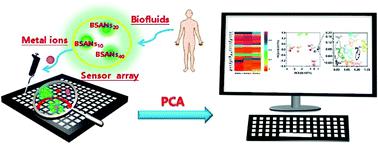Our official English website, www.x-mol.net, welcomes your feedback! (Note: you will need to create a separate account there.)
Fluorescent pattern recognition of metal ions by nanoparticles of bovine serum albumin as a chemical nose/tongue.
Analyst ( IF 4.2 ) Pub Date : 2020-08-21 , DOI: 10.1039/d0an01509a Yu-Lin Fan 1 , Yi-Fan Lu , Xu-Yin Ding , Nai-Hong Wang , Feng Xu , Guoyue Shi , Min Zhang
Analyst ( IF 4.2 ) Pub Date : 2020-08-21 , DOI: 10.1039/d0an01509a Yu-Lin Fan 1 , Yi-Fan Lu , Xu-Yin Ding , Nai-Hong Wang , Feng Xu , Guoyue Shi , Min Zhang
Affiliation

|
A sensor array mimicking a chemical nose/tongue based on bovine serum albumin nanoparticles (BSANsn) has been developed for the fluorescence pattern recognition of metal ions in biofluids. Three types of BSANsn (BSANs10, BSANs20, and BSANs40) show the same excitation/emission peak at 478/526 nm. According to the differential fluorescence variation, the sensor array shows particular fluorescence response patterns depending upon metal ions. Upon principal component analysis (PCA), it was found that the sensor array can distinguish 18 metal ions clearly at a concentration of as low as 10 μM. Moreover, different concentrations of metal ions and mixed metal ions of diverse kinds or valence states can be differentiated by the sensor in biofluids. In addition, the results were well consistent with those obtained with the traditional ICP-AES method.
中文翻译:

牛血清白蛋白纳米颗粒作为化学鼻/舌对金属离子的荧光模式识别。
基于牛血清白蛋白纳米颗粒 (BSANs n ) 模拟化学鼻子/舌头的传感器阵列已被开发用于生物流体中金属离子的荧光模式识别。三种类型的 BSAN n(BSAN 10、BSAN 20和 BSAN 40) 在 478/526 nm 处显示相同的激发/发射峰。根据不同的荧光变化,传感器阵列显示出取决于金属离子的特定荧光响应模式。通过主成分分析(PCA)发现,传感器阵列可以在低至 10 μM 的浓度下清楚地区分 18 种金属离子。此外,生物流体中的传感器可以区分不同浓度的金属离子和不同种类或价态的混合金属离子。此外,结果与传统 ICP-AES 方法得到的结果非常一致。
更新日期:2020-09-28
中文翻译:

牛血清白蛋白纳米颗粒作为化学鼻/舌对金属离子的荧光模式识别。
基于牛血清白蛋白纳米颗粒 (BSANs n ) 模拟化学鼻子/舌头的传感器阵列已被开发用于生物流体中金属离子的荧光模式识别。三种类型的 BSAN n(BSAN 10、BSAN 20和 BSAN 40) 在 478/526 nm 处显示相同的激发/发射峰。根据不同的荧光变化,传感器阵列显示出取决于金属离子的特定荧光响应模式。通过主成分分析(PCA)发现,传感器阵列可以在低至 10 μM 的浓度下清楚地区分 18 种金属离子。此外,生物流体中的传感器可以区分不同浓度的金属离子和不同种类或价态的混合金属离子。此外,结果与传统 ICP-AES 方法得到的结果非常一致。



























 京公网安备 11010802027423号
京公网安备 11010802027423号